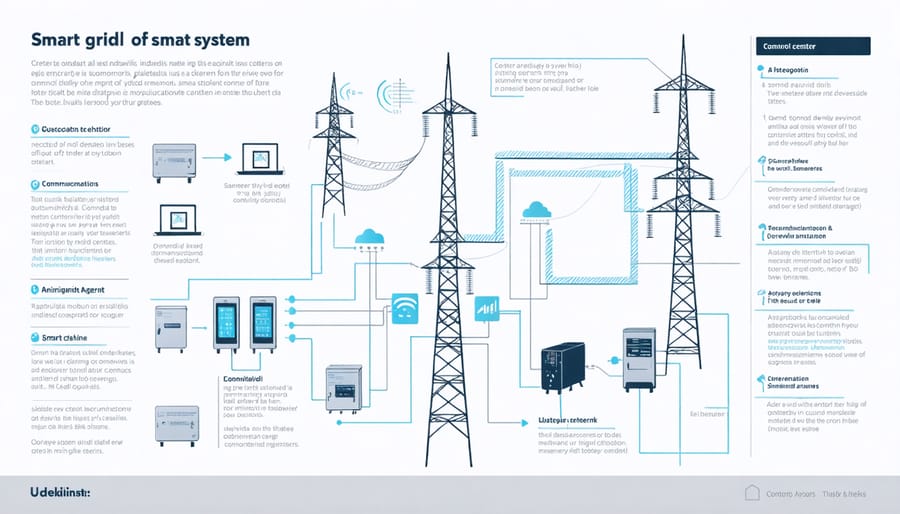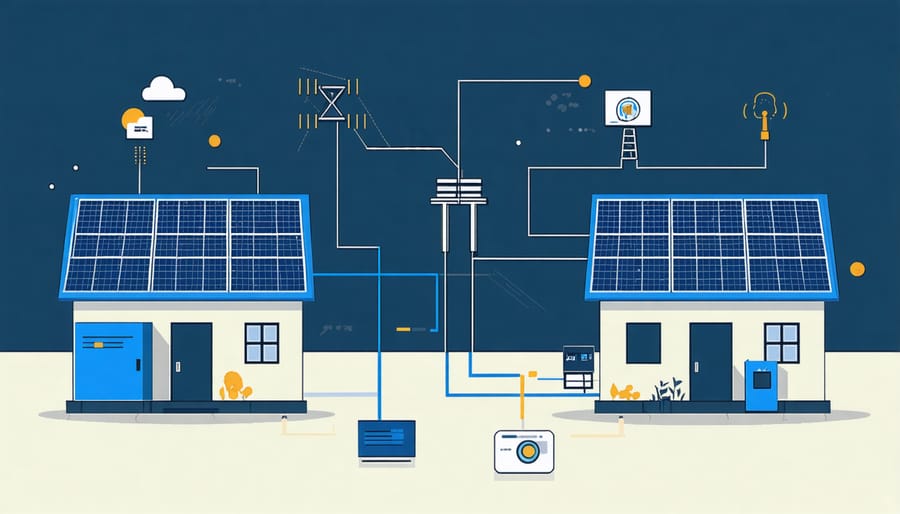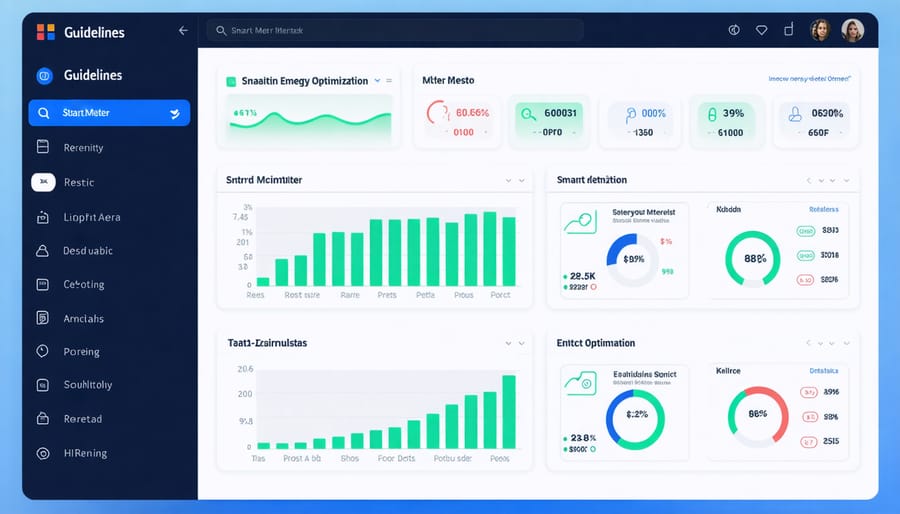Smart Grid Technology Makes Solar Energy Work Smarter (Not Harder)

Smart grid technology represents one of the most transformative innovations in modern energy infrastructure, merging traditional power distribution with advanced digital communications and automation. This sophisticated network of interconnected devices, sensors, and software revolutionizes how we generate, distribute, and consume electricity across Europe’s evolving energy landscape.
Imagine a traditional power grid transformed into an intelligent, self-healing network that automatically detects, responds to, and prevents power disruptions. Smart grids continuously monitor energy flow in real-time, enabling two-way communication between utilities and consumers while optimizing power distribution based on actual demand patterns. This technology serves as the backbone of Europe’s transition to renewable energy, particularly in regions leading solar energy adoption.
At its core, smart grid technology functions like an internet for electricity, creating a dynamic ecosystem where power generation, storage, and consumption seamlessly interact. From smart meters in homes to advanced distribution systems and automated substations, this infrastructure enables unprecedented control over energy resources while empowering consumers to actively participate in their energy management.
As we navigate the challenges of climate change and energy security, smart grids emerge as a crucial enabler of sustainable energy future, offering enhanced reliability, improved efficiency, and reduced carbon emissions across the European energy sector.
The Building Blocks of Smart Grid Technology

Smart Meters and Advanced Metering Infrastructure
Smart meters represent the foundation of modern grid intelligence, serving as sophisticated digital devices that record electricity consumption in real-time. These advanced devices replace traditional analog meters, providing detailed insights into energy usage patterns at intervals as frequent as every 15 minutes.
Operating through a secure wireless network, smart meters establish two-way communication between households and utility providers. They collect comprehensive data about electricity consumption, voltage levels, and power quality, transmitting this information automatically to the utility’s central system. This eliminates the need for manual meter readings while ensuring accurate billing and improved service delivery.
The Advanced Metering Infrastructure (AMI) forms the broader network that enables this smart communication. It consists of smart meters, communication networks, and data management systems working in harmony. When unusual patterns emerge, such as power outages or unexpected consumption spikes, the AMI instantly alerts utility providers, enabling swift response and maintenance.
For European consumers, this technology offers unprecedented visibility into their energy consumption. Through user-friendly interfaces, often accessible via smartphone apps, customers can monitor their usage in real-time, identify peak consumption periods, and make informed decisions about their energy use. This transparency helps households optimize their energy consumption, particularly beneficial for those with solar installations who can better match their energy usage with peak production times.
Communication Networks and Data Management
At the heart of smart grid technology lies a sophisticated communication network that enables real-time data exchange between various grid components. This advanced infrastructure utilises a combination of wireless and wired technologies, including fiber optics, cellular networks, and power line communications (PLC), to create a seamless flow of information.
The system processes vast amounts of data from smart meters, sensors, and grid equipment through multiple layers of communication. At the neighbourhood level, local area networks (LANs) collect data from individual households and businesses. This information then flows through wide area networks (WANs) to utility control centres, where powerful computing systems analyse the data to optimise grid operations.
Modern smart grids employ advanced encryption protocols and cybersecurity measures to protect sensitive information and ensure system reliability. Data management systems use sophisticated algorithms to process information about energy consumption patterns, grid status, and renewable energy generation in real-time.
These systems enable crucial functionalities such as automated meter reading, demand response programs, and dynamic pricing. For European utilities, this means better load balancing and more efficient integration of renewable energy sources. The communication infrastructure also supports remote monitoring and control of grid assets, allowing operators to quickly identify and respond to potential issues before they affect service quality.
Smart Grid Integration with Solar Systems
Real-time Monitoring and Control
Real-time monitoring and control systems form the backbone of smart grid technology, enabling precise management of solar energy production and consumption. Advanced sensors and smart meters continuously collect data about energy generation, consumption patterns, and grid conditions throughout the network. This data is processed by sophisticated software systems that provide instant insights and automated responses to maintain optimal grid performance.
These monitoring systems track key parameters such as voltage levels, power quality, and energy flow directions. When solar production peaks during midday, the system automatically adjusts to handle the increased power input, while during cloudy periods or at night, it seamlessly switches to alternative power sources to maintain stable supply.
Smart inverters play a crucial role in this process, converting solar-generated DC power to AC power while communicating with the grid management system. They can respond to grid conditions in milliseconds, adjusting power output to maintain stability and prevent overloading.
For European consumers and businesses, this translates to more reliable energy supply and better integration of renewable sources. The system’s ability to predict and respond to demand changes helps prevent power outages and reduces energy waste. Users can access real-time information about their energy consumption and production through user-friendly interfaces, enabling informed decisions about energy usage and helping to optimize cost savings.
This sophisticated monitoring and control infrastructure ensures that solar energy integration remains smooth and efficient, contributing to Europe’s renewable energy goals while maintaining grid stability.

Grid Stability and Load Balancing
Smart grid technology plays a crucial role in maintaining grid stability when integrating variable solar power into the electrical network. As solar generation fluctuates throughout the day due to weather conditions and sun position, smart grids employ sophisticated load balancing mechanisms to ensure consistent power delivery.
Advanced monitoring systems continuously track power generation and consumption patterns across the network in real-time. When solar production suddenly drops or spikes, smart grid controllers automatically adjust power flow from other sources or storage systems to maintain the perfect balance between supply and demand.
Load balancing algorithms prioritize and distribute power based on current needs, directing excess solar energy to storage systems during peak production and releasing it during periods of high demand or low generation. This intelligent management system helps prevent grid instability issues like voltage fluctuations and frequency deviations that could damage equipment or cause outages.
For European networks with high solar penetration, smart grids implement predictive analytics to anticipate production changes based on weather forecasts. This allows the system to proactively adjust conventional power plants and energy storage systems, ensuring smooth transitions between different generation sources.
The technology also enables demand response programs, where consumers can voluntarily reduce their consumption during peak times in exchange for incentives, further contributing to grid stability and efficient resource allocation.
Energy Storage Integration
Energy storage integration represents a crucial component of modern smart grid infrastructure, enabling efficient power management and grid stability. Advanced energy storage systems act as buffers, storing excess energy during peak production periods and releasing it when demand surges or renewable generation decreases.
In the European context, battery storage solutions play a vital role in maximising the potential of renewable energy sources. These systems work seamlessly with hybrid solar systems, allowing households and businesses to maintain consistent power supply despite variable weather conditions or grid fluctuations.
Smart grids utilise sophisticated monitoring and control systems to optimise storage deployment. When solar panels generate surplus electricity during sunny afternoons, the system automatically directs excess power to storage units. During evening peak hours or cloudy periods, stored energy can be strategically released to maintain grid stability and reduce dependency on conventional power sources.
The integration of storage systems also enables demand response programs, where consumers can participate in grid balancing by adjusting their energy consumption patterns. This creates a more resilient and flexible energy network, capable of responding to rapid changes in supply and demand while maintaining optimal efficiency and reliability.
Benefits for European Homes and Businesses
Energy Cost Optimization
Smart grids revolutionize energy cost management through sophisticated monitoring and control systems. By leveraging real-time data analytics and automated load balancing, these intelligent networks optimize energy distribution to reduce waste and lower operational costs. The integration of smart battery integration enables efficient energy storage and usage, allowing consumers to capitalize on off-peak pricing.
One of the key cost-saving features is demand response management, where the grid automatically adjusts consumption patterns based on electricity prices and grid demand. During peak hours, non-essential devices can be temporarily powered down or switched to stored energy, resulting in significant savings on utility bills.
For businesses and homeowners, smart meters provide detailed consumption data, enabling informed decisions about energy usage. The system identifies energy-intensive activities and suggests optimal times for operation, helping users reduce their environmental impact while maximizing cost efficiency.
Advanced forecasting algorithms predict energy demand and automatically optimize distribution, reducing transmission losses and infrastructure strain. This predictive capability, combined with real-time pricing information, allows consumers to schedule energy-intensive activities during periods of lower costs.
The system’s self-healing capabilities minimize downtime and maintenance costs by quickly identifying and isolating faults, ensuring reliable power supply while reducing operational expenses. This comprehensive approach to energy management typically results in 15-20% cost savings for end users.

Enhanced Grid Reliability
Smart grid technology significantly enhances power system reliability through advanced monitoring, automated fault detection, and rapid response capabilities. The integration of sophisticated sensors and real-time analytics enables grid operators to identify potential issues before they escalate into major problems, drastically reducing the frequency and duration of power outages.
These intelligent systems continuously monitor power quality parameters such as voltage levels, frequency stability, and harmonic distortion. When deviations occur, smart grids can automatically implement corrective measures, such as rerouting power through alternative pathways or adjusting voltage levels to maintain optimal service quality.
In Europe, where renewable energy integration is rapidly increasing, smart grids play a crucial role in maintaining system stability. They manage the variable nature of solar and wind power generation by implementing advanced load balancing and energy storage solutions. This capability ensures consistent power delivery even during periods of fluctuating renewable energy production.
The self-healing capabilities of smart grids are particularly noteworthy. When faults occur, these systems can isolate affected areas and automatically reconfigure the network to restore power to unaffected regions within seconds. This feature has proven especially valuable during extreme weather events, significantly improving the grid’s resilience.
For European businesses and households, this enhanced reliability translates to fewer disruptions, better power quality, and more efficient energy utilization. The result is a more stable and dependable electrical infrastructure that supports both economic growth and sustainable energy practices.
Future Developments and Opportunities
The future of smart grid technology holds transformative potential for Europe’s energy landscape. Advanced artificial intelligence and machine learning algorithms are being developed to enhance grid predictability and automate responses to energy demand fluctuations. These innovations will enable more sophisticated solar and wind integration, creating increasingly resilient and efficient power networks.
Blockchain technology is emerging as a game-changing solution for peer-to-peer energy trading, allowing households and businesses to directly exchange surplus solar energy. This democratisation of energy trading will create new market opportunities while optimising local energy consumption patterns.
The development of next-generation smart meters with enhanced communication capabilities will provide real-time insights into energy usage patterns. These advanced meters will integrate with home automation systems, enabling automatic load shifting based on energy prices and availability.
Vehicle-to-grid (V2G) technology is set to revolutionise energy storage capabilities. As electric vehicle adoption increases across Europe, parked cars will serve as distributed storage units, helping to balance grid loads during peak demand periods and storing excess renewable energy.
Quantum computing applications are being explored to optimise grid operations at unprecedented scales. This technology could revolutionise how we predict energy demand, manage grid stability, and coordinate millions of connected devices simultaneously.
The implementation of 5G networks will enable faster, more reliable communication between grid components, supporting the integration of millions of IoT devices and sensors. This enhanced connectivity will improve grid responsiveness and enable more sophisticated demand-response programs.
These developments will be supported by evolving regulatory frameworks across Europe, designed to encourage innovation while ensuring cybersecurity and data privacy. The future smart grid will be more resilient, efficient, and capable of supporting a fully renewable energy ecosystem, marking a significant step toward Europe’s sustainability goals.
Smart grid technology represents a pivotal advancement in Europe’s energy landscape, particularly in maximizing the potential of solar energy integration. By enabling bidirectional communication and real-time monitoring, smart grids have transformed how we generate, distribute, and consume electricity. For European consumers, this innovation translates into tangible benefits: enhanced energy efficiency, reduced utility costs, and more reliable power supply. The technology’s ability to balance supply and demand, manage peak loads, and integrate renewable energy sources has proven essential for creating a more sustainable and resilient energy infrastructure. As Europe continues its transition towards renewable energy, smart grid technology will remain instrumental in empowering consumers to participate actively in the energy market while supporting the continent’s ambitious climate goals. This sophisticated integration of digital technology with traditional power infrastructure represents not just an evolution in energy management, but a fundamental shift towards a more sustainable and efficient energy future.
Leave a Reply